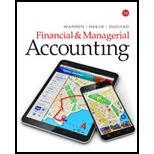
Financial and Managerial Accounting - With CengageNow
14th Edition
ISBN: 9781337577809
Author: WARREN
Publisher: CENGAGE L
expand_more
expand_more
format_list_bulleted
Concept explainers
Question
Chapter 25, Problem 25.5BE
(a)
To determine
Net present value method is the method which is used to compare the initial
To determine: The net present value of the Project 1 over an eight year life.
(b)
To determine
The project that provides the greatest net present value.
Expert Solution & Answer
Want to see the full answer?
Check out a sample textbook solution
Students have asked these similar questions
General Accounting
Solve this question
Given answer general Accounting
Chapter 25 Solutions
Financial and Managerial Accounting - With CengageNow
Ch. 25 - Prob. 1DQCh. 25 - Discuss the principal limitations of the cash...Ch. 25 - Prob. 3DQCh. 25 - Prob. 4DQCh. 25 - Prob. 5DQCh. 25 - Prob. 6DQCh. 25 - Prob. 7DQCh. 25 - Two projects have an identical net present value...Ch. 25 - Prob. 9DQCh. 25 - Prob. 10DQ
Ch. 25 - Prob. 11DQCh. 25 - Give an example of a qualitative factor that...Ch. 25 - Average rate of return Determine the average rate...Ch. 25 - Prob. 25.2BECh. 25 - Prob. 25.3BECh. 25 - Internal rate of return A project is estimated to...Ch. 25 - Prob. 25.5BECh. 25 - Prob. 25.1EXCh. 25 - Average rate of returncost savings Midwest...Ch. 25 - Average rate of returnnew product Galactic Inc. is...Ch. 25 - Calculate cash flows Natures Way Inc. is planning...Ch. 25 - Prob. 25.5EXCh. 25 - Cash payback method Lily Products Company is...Ch. 25 - Prob. 25.7EXCh. 25 - Net present value method for a service company AM...Ch. 25 - Net present value method annuity for a service...Ch. 25 - Prob. 25.10EXCh. 25 - Net present value method for a service company...Ch. 25 - Present value index Dip N' Dunk Doughnuts has...Ch. 25 - Net present value method and present value index...Ch. 25 - Prob. 25.14EXCh. 25 - Cash payback period, net present value analysis,...Ch. 25 - Internal rate of return method The internal rate...Ch. 25 - Prob. 25.17EXCh. 25 - Internal rate of return methodtwo projects Munch N...Ch. 25 - Prob. 25.19EXCh. 25 - Prob. 25.20EXCh. 25 - Net present value unequal lives Bunker Hill Mining...Ch. 25 - Net present value unequal lives Daisys Creamery...Ch. 25 - Prob. 25.1APRCh. 25 - Cash payback period, net present value method, and...Ch. 25 - Prob. 25.3APRCh. 25 - Prob. 25.4APRCh. 25 - Prob. 25.5APRCh. 25 - Prob. 25.6APRCh. 25 - Prob. 25.1BPRCh. 25 - Cash payback period, net present value method, and...Ch. 25 - Prob. 25.3BPRCh. 25 - Net present value method, internal rate of return...Ch. 25 - Prob. 25.5BPRCh. 25 - Capital rationing decision for a service company...Ch. 25 - Wind turbine capital investment analysis Central...Ch. 25 - Paper reclaim capital investment analysis The...Ch. 25 - Tire design capital investment analysis...Ch. 25 - Ethics in Action Danielle Hastings was recently...
Knowledge Booster
Learn more about
Need a deep-dive on the concept behind this application? Look no further. Learn more about this topic, accounting and related others by exploring similar questions and additional content below.Similar questions
arrow_back_ios
SEE MORE QUESTIONS
arrow_forward_ios
Recommended textbooks for you
 Managerial AccountingAccountingISBN:9781337912020Author:Carl Warren, Ph.d. Cma William B. TaylerPublisher:South-Western College Pub
Managerial AccountingAccountingISBN:9781337912020Author:Carl Warren, Ph.d. Cma William B. TaylerPublisher:South-Western College Pub Financial And Managerial AccountingAccountingISBN:9781337902663Author:WARREN, Carl S.Publisher:Cengage Learning,
Financial And Managerial AccountingAccountingISBN:9781337902663Author:WARREN, Carl S.Publisher:Cengage Learning, EBK CONTEMPORARY FINANCIAL MANAGEMENTFinanceISBN:9781337514835Author:MOYERPublisher:CENGAGE LEARNING - CONSIGNMENT
EBK CONTEMPORARY FINANCIAL MANAGEMENTFinanceISBN:9781337514835Author:MOYERPublisher:CENGAGE LEARNING - CONSIGNMENT- Principles of Accounting Volume 2AccountingISBN:9781947172609Author:OpenStaxPublisher:OpenStax College
 Cornerstones of Cost Management (Cornerstones Ser...AccountingISBN:9781305970663Author:Don R. Hansen, Maryanne M. MowenPublisher:Cengage Learning
Cornerstones of Cost Management (Cornerstones Ser...AccountingISBN:9781305970663Author:Don R. Hansen, Maryanne M. MowenPublisher:Cengage Learning Intermediate Financial Management (MindTap Course...FinanceISBN:9781337395083Author:Eugene F. Brigham, Phillip R. DavesPublisher:Cengage Learning
Intermediate Financial Management (MindTap Course...FinanceISBN:9781337395083Author:Eugene F. Brigham, Phillip R. DavesPublisher:Cengage Learning

Managerial Accounting
Accounting
ISBN:9781337912020
Author:Carl Warren, Ph.d. Cma William B. Tayler
Publisher:South-Western College Pub

Financial And Managerial Accounting
Accounting
ISBN:9781337902663
Author:WARREN, Carl S.
Publisher:Cengage Learning,

EBK CONTEMPORARY FINANCIAL MANAGEMENT
Finance
ISBN:9781337514835
Author:MOYER
Publisher:CENGAGE LEARNING - CONSIGNMENT

Principles of Accounting Volume 2
Accounting
ISBN:9781947172609
Author:OpenStax
Publisher:OpenStax College

Cornerstones of Cost Management (Cornerstones Ser...
Accounting
ISBN:9781305970663
Author:Don R. Hansen, Maryanne M. Mowen
Publisher:Cengage Learning

Intermediate Financial Management (MindTap Course...
Finance
ISBN:9781337395083
Author:Eugene F. Brigham, Phillip R. Daves
Publisher:Cengage Learning